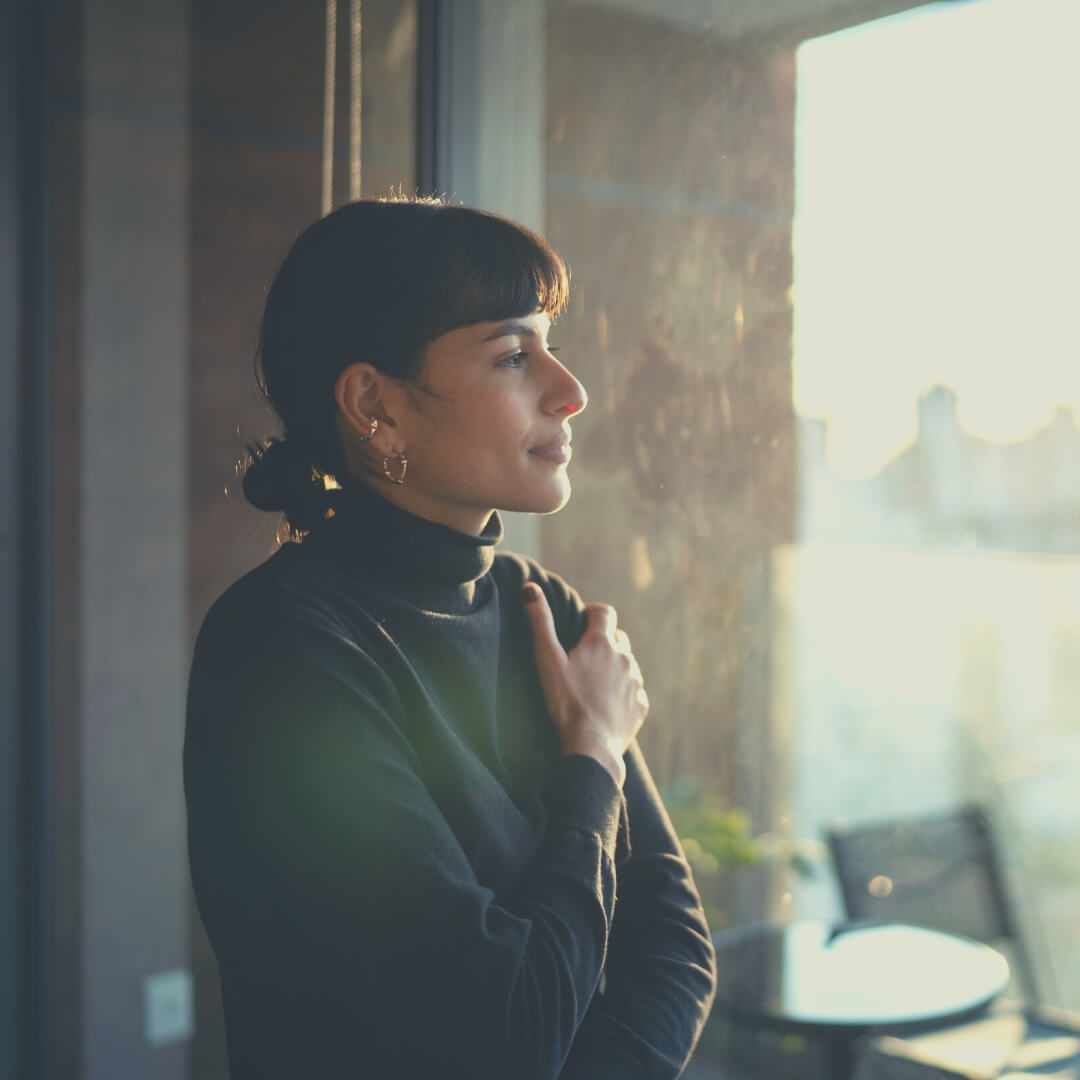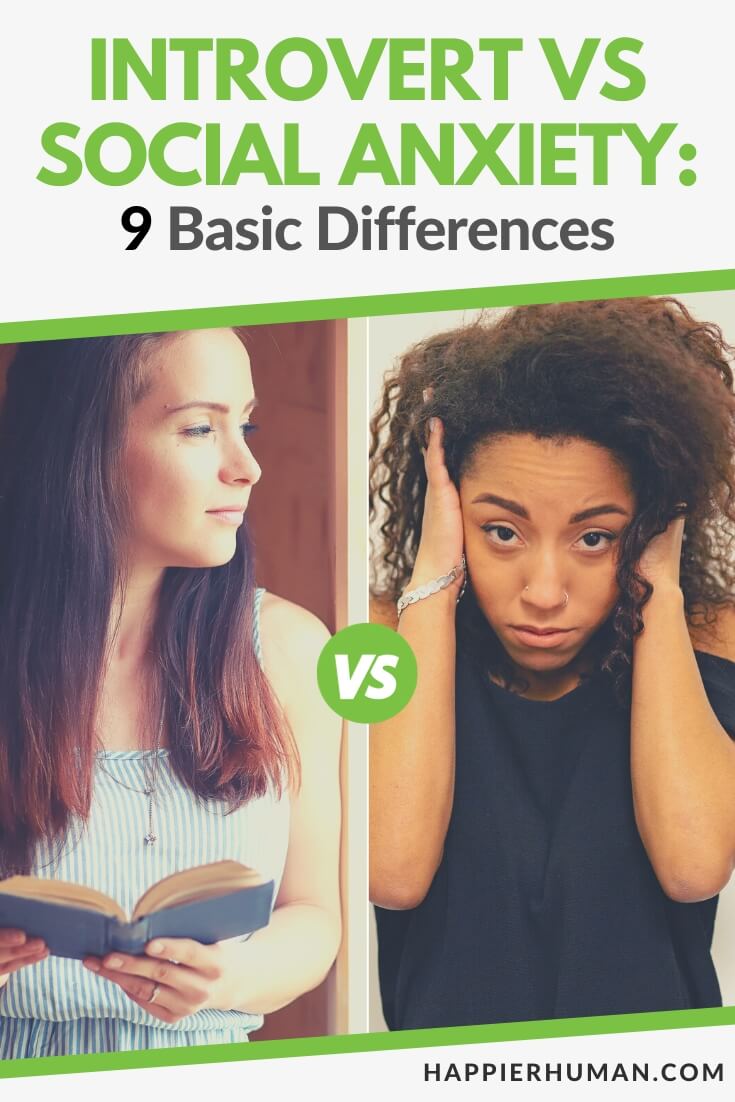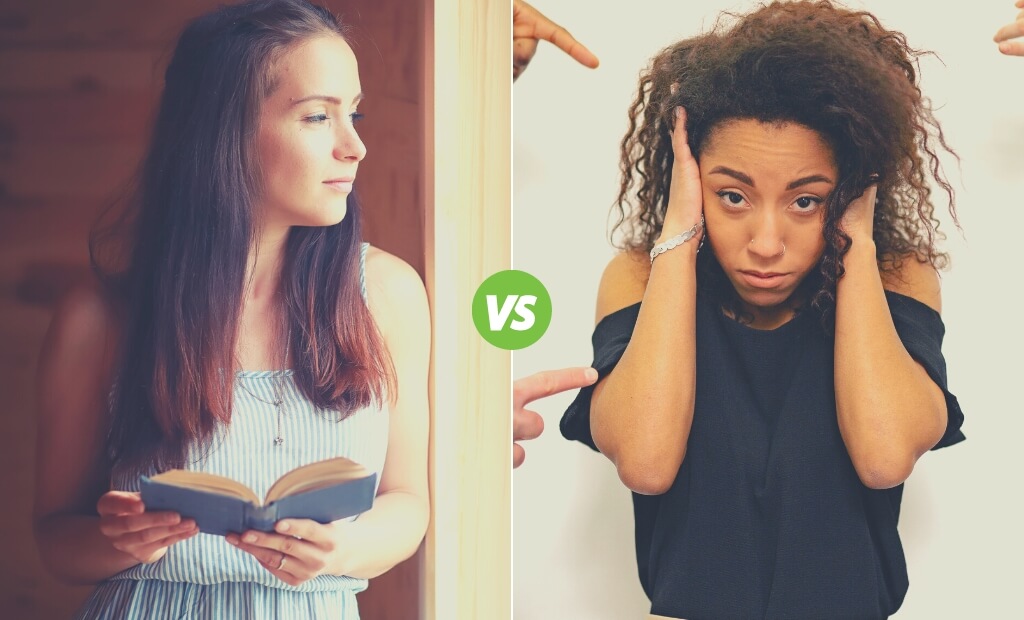There might be affiliate links on this page, which means we get a small commission of anything you buy. As an Amazon Associate we earn from qualifying purchases. Please do your own research before making any online purchase.
Introverts can be mistaken as socially anxious, shy, antisocial, or avoidant. On the flip side, those affected by social anxiety are sometimes mistaken for an introvert. Nothing is wrong with being an introvert or experiencing social anxiety.
Learning the key differences between introvert vs social anxiety can help you understand and embrace yourself. You're also able to determine if someone in your close circle is exhibiting social anxiety vs introvert traits or signs.
Ready to dive deeper? Let’s go!
What Is an Introvert?
According to Max Freyd’s (1924) simple definition, an introvert is an individual who has the “tendency to withdraw from social contacts.”
Psychologist Carl Jung (1923) was the first to come up with the terms introvert and extrovert in psychology. He used the terms to describe two opposing personality types. The element that sets the two types apart is the way they source their energy.
Jung viewed introverts as focusing inward on themselves. They feel alive and happy and get motivation from introspecting. Unlike extroverts who have a “tendency to make social contacts,” introverts prefer solitude.
Retreating away from social stimulation allows them to dig deep into their thoughts and creativity.
The need to frequently pull away from socializing helps explain why introverts are sometimes mistaken as having social anxiety. But introvert vs social anxiety is vastly different, as you will realize once you pore over the important differences below.
Jung’s description of introverts and extroverts later became the basis for the Myers-Briggs Type Indicator (MBTI).
Types of Introverts
Introversion falls on a spectrum, meaning someone can be somewhat introverted to very introverted. Introverts also come in different flavors and may swing from mildly to severely socially withdrawn. It all depends on what’s happening in their life at the time.
Below are the four primary types, common characteristics, and traits that can make them appear to have social anxiety:
What Is Social Anxiety?
Social anxiety, or social phobia, is a debilitating disorder known as social anxiety disorder (SAD). It is defined as “a long-term and overwhelming fear of social situations.”
The fear triggers anxiety and stems from a fear of rejection and negative judgment. According to the National Institute of Mental Health, individuals affected by SAD fear social interaction more around unfamiliar people or situations.
Almost everyone gets a little anxious or feels shy in social settings. With social anxiety, it is much more than shyness or nervousness.
It is a disorder, and it affects fifteen million American adults. For a socially anxious person, the feelings are extreme.
Social Anxiety vs Shyness
Social anxiety comes from persistent and intense fear. Getting anxious in or while approaching social situations stems from a deep-seated fear of being viewed negatively by others.
This comes from poor self-image and feeling insecure about how others will receive them. For example, they believe they will be rejected or humiliated for their appearance or actions.
As you may have already noticed, the common theme with both introversion and social anxiety is staying away from social situations. People in both groups are loners and can feel overwhelmed by social engagements.
Others may wrongfully judge them as antisocial or having an avoidant personality disorder.
What’s more is, of all the types of introverts, the anxious introvert and restrained introvert may more than likely get mistaken for someone with social anxiety.
Spotting the Difference between Introvert vs Social Anxiety
On the surface, introvert vs social anxiety appears to be one and the same. Indeed, introverts experience shyness, jitters, and apprehension. However, when you examine it closely, you begin to see the distinct differences.
In other words, introverts and those who have social anxiety stay away from socializing for completely different reasons. Let’s take a look at NINE key differences:
#1. Introvert is a personality trait; social anxiety is a mental disorder.
Personality types form from traits that are embedded mostly through upbringing along with childhood experiences. Carl Jung concluded that introversion is a personality trait.
Myer and Briggs later confirmed this theory and used it as a way to explain introverted personality types.

For example, introverts who take in and process information from the environment through sensing, thinking, and judgment have an ISTJ personality.
Long-term social anxiety is a chronic disorder diagnosed by a psychologist. Fifteen million American adults experience it almost every day.
Normal everyday social settings such as work, school, or walking in public cause them a significant amount of distress and anxiety.
SAD symptoms typically show up for the first time in childhood or the early teenage years. This is according to Mental Health America. The symptoms are triggered by the person’s perception of their social environment in relation to themselves.
They worry that people are thinking about them in a negative way. Many times, people are preoccupied with their own worries and daily routines.
#2. An introvert does not fear social interaction, but a socially anxious person does.
An introvert’s avoidance of social connection is driven by a different reason. They enjoy some level of social involvement. Sometimes, they crave it. At the same time, they don’t feel the need to always be around people.
While they feel comfortable socially connecting, they tend to feel their best when alone and in their thoughts. Introverts are self-assured and self-reliant and don’t necessarily feel lonely in their solitude.
It’s a part of their personality to socially confine themselves to recharge.
Those with SAD may yearn to connect socially. However, an overwhelming fear of negative judgment or rejection stops them. They fear messing up in public which leads to the fear of getting criticized for mistakes.
Some think people may view them as stupid or clumsy in their efforts to hide their anxiety. For example, rubbing their palms together or biting their nails in an effort to calm their nerves.
#3. Introverts do not fear being the center of attention unlike someone with social anxiety.
A great day in the life of someone with social anxiety is one where they go about their daily life unnoticed. In some sense, they wish they were invisible.
They hate being seen. That comes from having an ongoing feeling they are being watched and negatively judged.
So, they’ll go out of their way to hide themselves or avoid activities that involve the spotlight. For example, speaking in a group setting or giving a presentation.
As much as an introvert enjoys being alone, they have no problem with getting thrown into the spotlight. They won’t break out sweating.
They don’t wish the earth could open and swallow them up out of fear of embarrassment. They’re not self-conscious like those with social anxiety or uncomfortable with others looking at them.
#4. Social anxiety triggers symptoms but not introversion.
Anxiety symptoms usually affect those with an ongoing fear of being around unfamiliar people or performing in social situations.
Strong physical symptoms include a racing heartbeat, sweaty palms, panic attacks, trouble breathing, and stomach discomfort.
The person may isolate themselves to cope with the symptoms. However, social isolation can lead to loneliness and more anxiety.

Chronic anxiety is not a feature of introverted personalities. Introverts regularly introspect and dig deep into their thoughts. This characteristic helps them develop greater self-awareness and emotional intelligence.
If they notice they’re getting anxious or depressed, they are somehow able to stop themselves from spiraling out of control.
If it means allowing people back into their ‘space’, they’ll prefer that over wallowing in despair or depressive thoughts.
#5. Introverts are happy in isolation but not socially anxious people.
Make no mistakes, introverts love being by themselves, especially when they’re ‘peopled-out’. Solitude is like downtime for them to regroup and turn up the self-care.
They aren’t necessarily feeling cut off from fun, isolated, sad, or down. Take it from an introvert, we’re notorious for throwing solo parties during our social retreat phases.
Psychology experts notice those with ongoing social anxiety vs introverts aren’t able to cope in social settings or alone. They withdraw to cope with anxiety feelings. However, withdrawing from social life does not support mental health.
While social interaction is overwhelming, staying withdrawn to avoid people often backfires. They are more likely to experience sadness, loneliness, anxiety, and depression in isolation.
#6. Introverts can go on a social binge, unlike those with social anxiety.
Sometimes introverts lose themselves when they reconnect, turning things into a socializing spree. During this phase, they’re hanging out with friends, going to parties, out shopping, and dining.
They are surprisingly talkative and may shock others with their intellect and sense of humor. It’s during this mental shift that they are most often mistaken for extroverts or someone bipolar.
Behaving like this contradicts an introvert’s core personality traits, but they don't focus on negative judgment. Once they feel relieved, they tend to go back to their shell or safe space, away from the rest of the world.
Someone with SAD is unlikely to embark on a socializing binge. That is equivalent to confronting their fear or phobia. They’ll have difficulties functioning and would rather stay home and binge-watch movies.
#7. Social anxiety interferes with daily functioning but not introversion.
Dealing with excessive and irrational fears of people or performance in social settings can disrupt the individual’s life.
Functioning in everyday social settings is also overwhelming and difficult for those with SAD.
Consequently, they have trouble making friends or dating, as it requires going outdoors and mingling with people. Even if they’re aware of their fear of social contact, they feel powerless to stop it.
On an average day, social introverts do not go through these experiences. The same can be said for thinking and restrained introverts, for the most part.
Sure enough, they’ll experience occasional nervousness, fear, or anxiousness, especially in uncertain situations.
As for anxious introverts, they’re the only ones who mostly feel shy and awkward in public. Still, they’re able to continue daily life functions. Those faced with social anxiety find shyness and feeling awkward debilitating.
#8. Social anxiety increases the risk of other disorders, but not being an introvert.
Those who are socially anxious on a chronic level find themselves in a social anxiety and social withdrawal loop.
For starters, they also lose out on opportunities to develop social skills by interacting with peers. More significantly, researchers found that the anxiety-withdrawal loop increases their risk of other mental disorders.
Here’s how this can happen. Fear and anxiety symptoms cause them to avoid social environments. They withdraw to cope with these feelings. Withdrawal often relieves their anxiety.

Due to feeling safe in isolation, they continue to rely on social avoidance for relief. This of course is an unhealthy coping style.
Increasing withdrawal over time only makes social anxiety worse. It also pushes up the risk of substance abuse, depression, and suicide.
On the other hand, those risks tend to be lower for introverts. These reserved-by-nature individuals are content and happy in their self-imposed state of isolation
#9. Introversion does not go away, while social anxiety can.
Introverts can tolerate isolation and being socially active. They socially withdraw because that’s their personality style. Even if they desire to, they can’t simply get rid of their introverted personality traits.
Moreover, their choice to stay to themselves isn’t driven by social anxiety. It’s a trait. It’s also something therapy can’t fix. As one article states, “You can’t “turn” into an introvert or extrovert, just like a dog can’t turn into a horse.”
With social anxiety, it’s not a personality trait. It’s a disorder driven by fear. People develop a socially anxious temperament based on their childhood experiences. Doctors noticed signs and symptoms show up mostly during the teenage years.
Symptoms may improve with age but not for everyone. Furthermore, the mental condition does not go away on its own.
Final Thoughts on Introvert vs Social Anxiety
If you’re an introvert, that’s okay. If you struggle with social anxiety, no problem. As children, we don’t really get to choose the environment we are born and raised in. We don’t have control over how it impacts our personality and adulthood experiences.
However, as adults, we can choose to change or improve the parts of us we don’t find flattering. Those changes can have a positive impact on our relationships and overall life experiences.
If you’re someone with chronic or debilitating social anxiety, therapy can be beneficial. Treatment, such as behavioral therapy or exposure therapy, can help you manage anxiety symptoms and reduce fear related to social exposure.
Conversely, you don’t need therapy to fix your introverted personality. However, therapy can be a tool to help you manage social withdrawal tendencies that interfere with personal and professional growth.
Learn more about 11 Introvert Strengths and Qualities That Help in Life.
And if you're looking for more articles about introverts, be sure to check out these blog posts:
- Empaths VS Introverts: 7 Basic Differences
- 15 Quick Ways to Make an Introvert Miss You
- 11 Introvert Networking Tips That Won’t Make You Feel Exhausted
Finally, if you want to identify YOUR personality type, then take one of these 11 personality tests to better understand what makes you tick.


